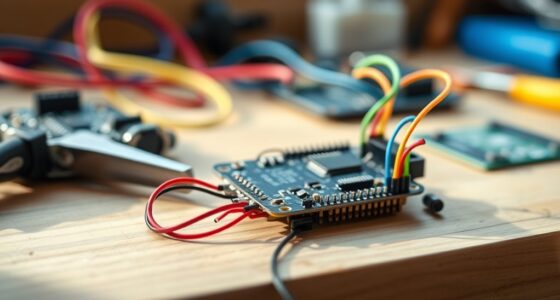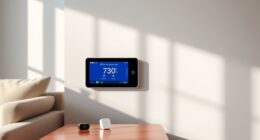To fix slow Wi-Fi at home, start by placing your router in a central, elevated spot away from walls and large metal objects. Reduce interference by moving devices like cordless phones and microwaves away from the router, and switch to the 5 GHz band if possible. Manage device activity to prevent overload, and restart or update your router regularly. Following these steps will help improve your Wi-Fi speed and coverage; keep going to learn more effective tips.
Key Takeaways
- Optimize router placement centrally, elevated, and away from walls or interference sources.
- Switch to the 5 GHz band and select less crowded Wi-Fi channels for less congestion.
- Minimize interference by relocating household devices like cordless phones and microwaves away from the router.
- Regularly restart your router, update firmware, and reset if issues persist to maintain performance.
- Limit bandwidth-heavy activities and manage connected devices to prevent network overload.

Are you tired of sluggish Wi-Fi slowing down your online activities? If so, the first thing to check is your router placement. The location of your router plays a vital role in determining your Wi-Fi speed and coverage. Place it in a central spot in your home, away from walls, metal objects, and large appliances that can block signals. Elevate the router off the floor, ideally on a shelf or table, to guarantee better signal distribution. Avoid hiding it inside cabinets or behind furniture, as these can considerably reduce signal strength. By positioning your router thoughtfully, you give your Wi-Fi the best chance to reach every corner of your home without unnecessary interruptions.
Next, consider potential interference sources that could be disrupting your Wi-Fi signal. Many common household devices emit signals that can interfere with your router’s frequency, such as cordless phones, baby monitors, microwave ovens, and Bluetooth devices. Keep these devices away from your router whenever possible, especially on the same frequency band. If your router operates on the 2.4 GHz band, it’s more prone to interference due to the crowded spectrum. Switching your router to the 5 GHz band can often help, as it’s less congested and offers higher speeds, though it has a shorter range. Also, check for neighboring Wi-Fi networks using the same channel. Using a Wi-Fi analyzer app can reveal which channels are crowded, allowing you to switch your router to a clearer channel for a more stable connection.
Improving your router’s placement and reducing interference can also benefit from understanding wireless technology principles, which influence signal strength and quality. Adjusting your router’s placement and minimizing interference sources can drastically improve your Wi-Fi speed. Once you’ve relocated your router to a more critical position and reduced interference, restart it to apply the changes. If your connection still feels sluggish, consider updating your router’s firmware or resetting it to factory settings. Sometimes, outdated firmware can cause performance issues, and a reset can clear out any bugs. Additionally, ensure your connected devices are not overwhelmed with background downloads or multiple streaming activities happening simultaneously, as these can also slow down your Wi-Fi. By paying attention to router placement and interference sources, you’re taking essential steps toward a faster, more reliable internet experience at home.
Frequently Asked Questions
How Can I Identify the Source of Wi-Fi Interference?
To identify the source of Wi-Fi interference, start by checking for signal interference from nearby electronic devices like microwaves or cordless phones. Use a Wi-Fi analyzer app to scan your network and spot device conflicts or weak signals. Move your router away from potential sources of interference, such as thick walls or metal objects. This helps you pinpoint and reduce interference, improving your Wi-Fi speed and reliability.
What Is the Best Way to Update My Router’s Firmware?
You should check your router’s admin panel for the firmware update option, usually found under the “Settings” or “Management” section. Download the latest firmware directly from the manufacturer’s website for added security. Regular firmware updates improve your router’s performance, fix bugs, and enhance router security against potential threats. Make sure to follow the instructions carefully to avoid any issues during the update process.
How Do I Secure My Wi-Fi Network From Unauthorized Access?
Oh, you’d love to keep your Wi-Fi open for everyone, right? Well, instead, secure your network by enabling password encryption and device authentication. Change default passwords, use strong, unique ones, and activate WPA3 if available. Regularly update your firmware to patch security flaws. This way, only trusted devices connect, keeping unwanted guests out—and saving you from potential cyber headaches. It’s security, not a guest list.
Can Changing My Wi-Fi Channel Improve Speed?
Yes, changing your Wi-Fi channel can improve speed by enhancing channel optimization and signal clarity. Interference from nearby networks often causes slow speeds, but switching to a less crowded channel reduces congestion. Use your router’s settings or a Wi-Fi analyzer app to identify the best channel. By doing so, you’ll experience a more stable connection, faster data transfer, and better overall Wi-Fi performance at home.
What Are the Signs My Router Needs Replacing?
You’ll know your router needs replacing if you notice persistent signal strength issues or frequent disconnections. Poor placement, like being tucked away or obstructed, can worsen performance, so make certain it’s centrally located and elevated. If updating placement and changing channels doesn’t improve speeds, it’s likely time to get a new router. Modern routers offer better coverage and stronger signals, helping you stay connected smoothly.
Conclusion
Now that you’ve navigated the maze of troubleshooting steps, your Wi-Fi should flow like a smooth river instead of a sluggish stream. Think of your connection as a busy highway—clear lanes and quick traffic mean faster downloads and smoother streaming. With these simple tweaks, you’ve rewired your digital landscape, turning your home into a tech oasis. Say goodbye to buffering and hello to seamless browsing, because a faster Wi-Fi isn’t just a fix—it’s your new digital superpower.









